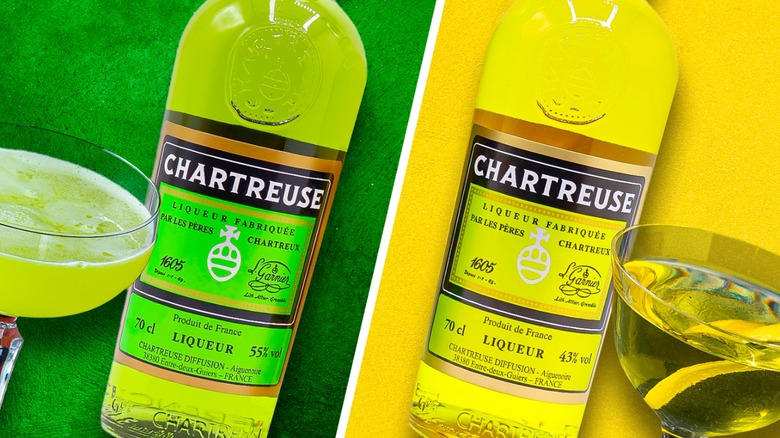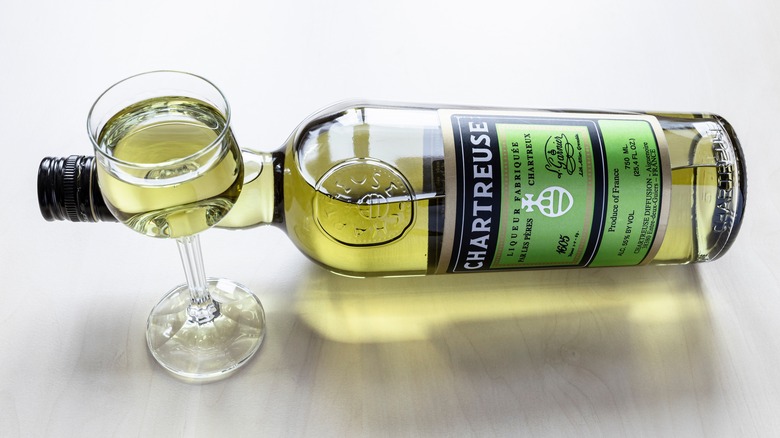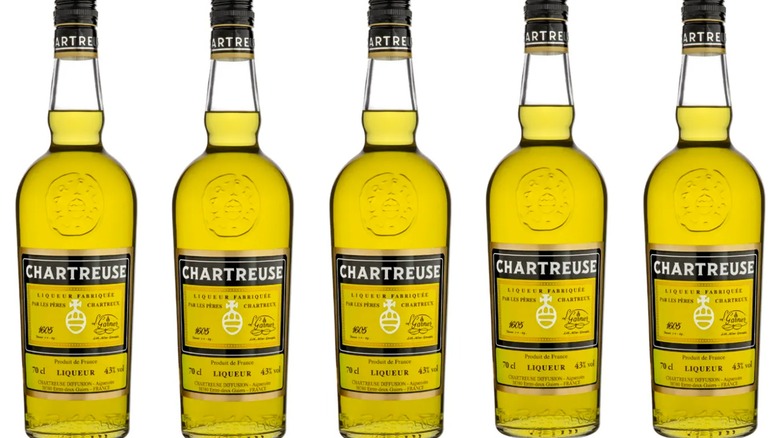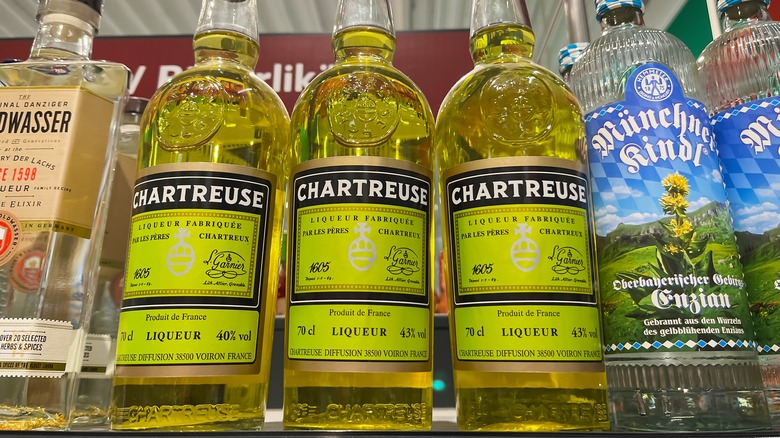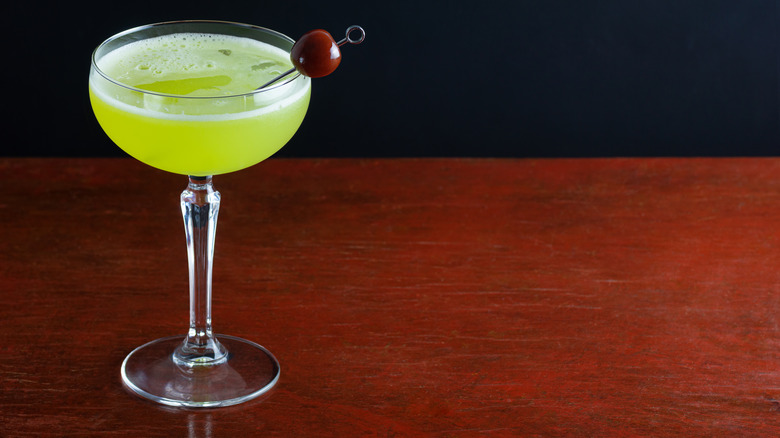Green Vs Yellow Chartreuse: What's The Difference?
We may receive a commission on purchases made from links.
Legendary writer Hunter S. Thompson's holy trinity for inspiration was marijuana, cocaine, and Chartreuse. In his song "'Til the Money Runs Out," Tom Waits sings about buying "a pint of green Chartreuse" when "ain't nothin' seems right." A round of Chartreuse shots even features in one scene in Quentin Tarantino's "Death Proof," where an actor lays eyes on the bright green liqueur and is moved to exclaim, "What the f*k is that?!"
Apart from its rich, vivid hues, this dimensional liqueur is known for its storied history. The recipe is protected by the Carthusian monks of the French Alps (yes, really), who have been the exclusive producers of this herbal elixir since the 1700s. The recipe for Chartreuse is based on 'The Elixir of Long Life,' an ancient manuscript given to the monks in 1605 by François Annibal d'Estrées, a marshal under King Henry IV. The sacred alchemical manuscript is written in code, which took the monks over 100 years to decode, and to this day, the monks follow a system of checks and balances in which each person only knows a portion of the recipe. In other words, no single person on Earth knows the full recipe of Chartreuse – and the Carthusian monks follow a vow of silence, to boot.
Today, there are two types of Chartreuse, green and yellow, each with its own unique flavor and formula. Beyond their colors, the main differences that separate the green from the yellow are their base spirits, flavors, and potencies.
What is green Chartreuse?
Green Chartreuse is the classic flagship Chartreuse variety. The liqueur is so iconic, in fact, that the color "chartreuse" takes its name from the vivid beverage. Although, when it first hit the scene during the late 1700s, green Chartreuse was originally called "health liqueur."
The recipe for the Chartreuse that fans know and love today was developed by apothecary Brother Jérôme Maubec in 1737. Fast forward nearly 300 years and modern production has grown to a mammoth scale of over one million bottles per year, which has led to the outsourcing of advertising, sales, and packaging. Still, production remains entrusted to a small team of two monks alone.
Despite its lock-and-key secrecy, fans do know that Chartreuse is made from 130 different herbs and spices, which get macerated for 18 hours and then aged in vintage oak casks. According to Chartreuse's official website, "Chartreuse Verte' derives its unique character from its natural color, its power and its aromatic complexity from 130 plants, flowers, bark, roots and spices. Its development requires several weeks of work and is done in various stages." The result is a complex palette with floral and menthol top notes, followed by an earthy, herbaceous, woody taste with deep peppery intensity. (We like to add a slug to our hot cocoa.)
What is yellow Chartreuse?
Yellow Chartreuse wasn't developed until the 1830s. Per the lore, the year was 1838, and one member of the Carthusian Monastery of the Grande Chartreuse was experimenting with a clear liqueur made from lemon balm. Simultaneously, another brother was conducting a symbiotic alchemical endeavor to create a yellow-hued liqueur from an entirely different lineup of herbs. When they combined their concepts into a single spirit, yellow Chartreuse was born (or, so the story goes). Thanks to green Chartreuse's steadfast and widespread existing fan base, yellow Chartreuse found a ready market across France and Italy upon its release.
Yellow Chartreuse tastes slightly sweeter and less intensely sharp than its green counterpart. In the absence of the woodiness, the liqueur's subtler notes become more pronounced in the yellow version. The spiced, fruity, slight sweetness is allowed to shine for a softer profile. Due to the secrecy surrounding the French liqueur's recipe, it's tough to identify what exact elements separate the yellow from the green. But, per the official Chartreuse website, "Chartreuse Jaune is characterized by its sweetness, spicy scents and natural color from 130 plants, flowers, bark, roots and spices. Its production is significantly different from the Green Chartreuse and requires several weeks of work in various stages."
Green Chartreuse tastes strong, herbaceous, and woody, while yellow Chartreuse tastes spiced, floral, and sweet
The only ingredients listed by Chartreuse's website are alcohol, sugar, water, and vegetable substances," with identical ingredients provided for both the green and yellow versions. Both versions are also described as aging in oak casks "for a long time." For all its secrets, fans do know a few specifics about the production of Chartreuse, like the source of the color. Green Chartreuse is colored by vegetal chlorophyll, and yellow Chartreuse is colored by saffron, both naturally occurring ingredients in the wild. No artificial colorants here! The duo is also made from different base spirits, with green Chartreuse being made from sugar beets and yellow Chartreuse being made from grape distillate.
Beyond color, the most obvious difference between yellow and green Chartreuse is their tastes. Green Chartreuse has a stronger and more medicinal taste than yellow Chartreuse (talk about an Elixir of Long Life!), which presents flavorful notes of spices, flowers, and honey. Green Chartreuse tastes heavily herbaceous and peppery, strong and woodsy, while yellow Chartreuse is softer and sweeter (but still packs an intense floral punch).
Somewhere in its top-secret distillation process, green Chartreuse comes out stronger, clocking in at 55% ABV, while yellow Chartreuse totes a tamer 43% ABV. Although, for reference, standard full-proof spirits like tequila, bourbon, gin, vodka, and whiskey are 40% ABV, making Chartreuse technically overproof and totally obliterating the elitist "liqueurs aren't real liquor" mixology stereotype.
Green and yellow Chartreuse are used to create wildly different cocktails
Speaking of mixology, the cocktail revival wave of the early 2000s helped usher Chartreuse into a new era and attract a new and enduring fanbase. In 2022 alone, Chartreuse sales exceeded $30 million – which rules on several levels because, according to the National Catholic Register, the sales "have provided steady income to the Carthusian Order and enable the monks to fully dedicate themselves to their life of prayer, study, and silence."
Both green and yellow Chartreuse are commonly sipped chilled as a digestif, but they're also crucial ingredients in a number of dimensional, mature cocktails. Green Chartreuse is a key player in the Last Word (green Chartreuse, gin, lime juice, maraschino liqueur) and Bijou cocktails (green Chartreuse, gin, sweet vermouth, orange bitters), as well as the similar Tipperary #1, which skips the bitters and swaps the gin for Irish whiskey. It's also commonly used to offset the sweetness in Irish Coffees and Gimlets.
Yellow Chartreuse stars in the experimental cocktail Alaska (yellow Chartreuse, gin, and cold water), Greenpoint (yellow Chartreuse, straight rye whiskey, sweet vermouth, and Angostura bitters), avant-garde Naked & Famous (yellow Chartreuse with smoky mezcal, bittersweet Italian amaro, and lime juice), and Flying Dutchman cocktails (juniper-forward Genever, citrusy triple sec, and orange bitters). For a super strong, all-time dimensional sipper, green and yellow Chartreuse can meet in the same glass for swizzles and the Episcopale cocktail, stirred together with ice and then strained into an ice-filled rocks glass.
